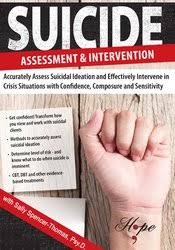Sally Spencer-Thomas – Suicide Assessment and Intervention, Assess Suicidal Ideation and Effectively
$200 Original price was: $200.$75Current price is: $75.
Shopping Instructions:
- DISCOUNT 15% : SHOP15
- Product Delivery: Within 1 – 12 hours after purchase.
This seminar will transform how you view and work with suicidal clients and give you the clinical tools you need to save lives.
Sally Spencer-Thomas – Suicide Assessment and Intervention, Assess Suicidal Ideation and Effectively
Losing a client to suicide is your worst nightmare. And there inevitably comes a time when the suicidal client is more than just an intangible dread. When an actual person, suffering and sitting in your office reveals they are having suicidal thoughts, many clinicians are left feeling unprepared, frightened, and unsure what to do next. The weight of keeping someone alive can steer you in the direction of avoidance. Desperate and alone, suicidal clients can find themselves passed from one therapist to the next. And that’s not care.
Don’t let fear push you away.
This seminar will transform how you view and work with suicidal clients and give you the clinical tools you need to save lives.
Full of thought provoking lecture, engaging case studies, and guided instruction on a host of powerful clinical applications, this seminar will provide you with the tools you need to:
- Assess for suicidal risk and identify implicit and explicit expressions of suicidal thought.
- Formulate a game-plan for crisis when suicide is imminent.
- Intervene in suicidal despair with proactive approaches derived from the evidence-based efficacy of CBT and DBT.
- Effectively use targeted language with suicidal clients that will help you avoid stigma and successfully communicate your compassion.
- Provide innovative grief support resources that connect clients and clinicians with other survivors of suicide and suicide loss
Leave this seminar feeling confident and capable to work with suicidal clients and guide them out of the darkness and back into the light!
- Assess individuals at risk of suicide with a clinical approach that identifies both explicit and implicit expressions of suicidal thought.
- Ascertain key indicators of imminent suicide and develop a strategy for determining when and how to hospitalize clients.
- Formulate a CBT and DBT oriented case conceptualization that addresses how to effectively work with specific populations including veterans and the elderly.
- Employ a collaborative safety approach to help clients survive a suicidal crisis while avoiding the pitfalls of suicide contracting and the false sense of security and decreased clinical vigilance that can accompany their use.
- Connect suicidal clients with communication strategies that convey your compassion and support and effectively strengthen the therapeutic alliance.
- Reduce access to lethal means with tips and tactics for implementing a multi-systemic approach that incorporates the suicidal person’s social connections into their safety plan.
Would you like to receive Sally Spencer-Thomas – Suicide Assessment and Intervention, Assess Suicidal Ideation and Effectively ?
Suicide: Who, When, How and Where
- Addiction recovery
- Trauma-informed care
- Populations with multiple risk factors
- Suicide attempt survivors – learning from their experience
- Upstream clinical practices: reaching people before the point of crisis
Elicit Key Information from Suicidal Clients: Assessment and Level of Risk
- Implicit and explicit expressions of suicidal thoughts
- Communicating caring: Language to impart compassion and avoid stigma
- Suicide risk assessment
- SAFE-T
- PATH WARM
- Ideation, plan, means, intent
- Level of risk
Formulate Treatment Plans that Help Clients Regulate Emotions and Make Them Feel Valued and Connected
- Collaborative safety planning (or “Why Suicide Contracting is Dead”)
- Proactive approaches to decrease the likelihood of suicidal despair
- Multi-system approaches – support systems
- Evidence-based treatments:
- Cognitive Behavioral Therapy
- Cognitive restructuring strategies
- Emotional regulation exercises
- Behavioral Activation
- Dialectical Behavior Therapy
- How to organize a skills training group
- Tips for phone coaching
- Relapse prevention plans
- Reduce access to lethal means
- Working with specific populations: veterans, the elderly
- Cognitive Behavioral Therapy
Confidently Handle Crisis Situations
- Conduct a behavioral chain analysis
- Validating reasons for suicide
- Identify reasons for living
- Use distress tolerance and CBT skills to manage a crisis
- When and how to hospitalize
Suicide Grief Support and Innovative Suicide-Specific Care
- Implement Suicide Grief Support
- Understand the unique nature of suicide grief
- Peer-based support: Connect clients to other survivors of loss
- Access and Reclaim compassion
- Somatic resourcing
- Remembered resources
- Assess clients self-talk
ReInvest in a Life Worth Living: Rekindle the Desires of the Heart
- The PIE of life – brainstorm possibilities of growth
- Cultivate social connection and re-engagement
- Support and grief groups
- Toxic people
- Working with families impacted by loss
- Choice and perspective
- Foster gratitude and a spirit of contentment after loss
- Measurements of Post-Traumatic Growth
Related products
NLP & Hypnosis
NLP & Hypnosis
NLP & Hypnosis
NLP & Hypnosis
NLP & Hypnosis
iAwake Technologies – Beginner’s Mind (Neuroflow Series) [6 WebRips – WAV User Manual – PDF]
NLP & Hypnosis
NLP & Hypnosis










![Iawake Technologies – Beginner’s Mind (neuroflow Series) [6 Webrips – Wav User Manual – Pdf]](https://copicourse.com/wp-content/uploads/2021/08/iawake-technologies-beginners-mind-neuroflow-series-6-webrips-wav-user-manual-pdf-300x400.jpg)

